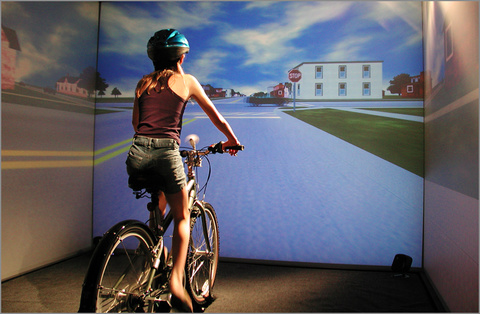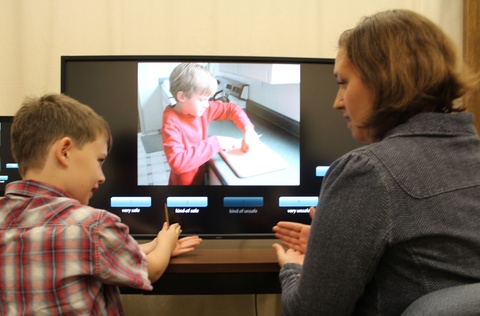Breadcrumb
Research on Risk Factors for Unintentional Childhood Injuries
Immature Perceptual-Motor Skills

According to J. J. Gibson, adaptive behavior within the environment depends upon perceiving affordances, or the fit between one’s own physical characteristics and the properties of the environment in which actions take place. Although accidents are complex phenomena and undoubtedly have several root causes, errors in judging the relation between one’s physical abilities and the demands of the situation may be one important factor contributing to accident risk. For example, some pedestrian accidents may result when children make errors in judgment about their ability to cross traffic gaps. Others may result when children have difficulty in acting on their gap choices. We study developmental changes in children’s ability to perceive and act on affordances, and how immature perceptual-motor skills may put children at risk for injury. The overarching aim of this research is to bring together the study of basic and applied issues into a single program of research (Schwebel, Plumert, & Pick, 2000).
Children's Overestimation of Their Physical Abilities
Our early work on children’s safety focused on children’s overestimation of their physical abilities (Plumert, 1995; Plumert & Schwebel, 1997; Schwebel & Plumert, 1999). We examined this question by asking 6- and 8-year-olds and adults to make judgments about their ability to perform a set of physical tasks (e.g., judging whether an object on a shelf was reachable). The tasks were adjusted so that sometimes they were within and sometimes they were beyond an individual participant’s ability. We found that 6- and 8-year-olds routinely overestimated their ability to perform the tasks when they were just beyond and well beyond their ability. In addition, 6-year-olds who overestimated their abilities more also had a history of more injuries requiring medical attention. This work shows that accuracy in judging affordances develops well into childhood, and that children who are poorer at judging affordances may also be at greater risk for injury.
Judging and Acting on Dynamic Affordances
Our recent work on how immature perceptual-motor skills may put children at risk for injury has focused on judging and acting on dynamic affordances (i.e., affordances that change over time). In particular, we have been studying how child and adult cyclists choose gaps and time movement when crossing roads. This is an interdisciplinary project, involving collaboration between Psychology and Computer Science faculty and students. (For a more complete description of this research, visit the Hank Virtual Environments Lab website.)
Road crossing is a common, everyday task that involves perceiving and acting on affordances involving moving objects. As such, road-crossing decisions and actions provide a window into perceptual-motor functioning in both children and adults (Plumert, Kearney, & Cremer, 2007). To successfully select a gap that affords crossing, individuals must accurately judge the temporal size of the gap in relation to the time required to cross the gap. To successfully act on a gap decision, individuals must begin moving so that they cut in closely behind the lead vehicle in the gap, while crossing as quickly as possible. Importantly, given the dynamic nature of traffic, gap decisions and crossing movements must be tightly linked. That is, selecting a gap that affords crossing can lead to poor outcomes if the child delays too long before moving, and precisely coordinating movement can also lead to poor outcomes if the child selects a gap that is too small to afford safe crossing.
In a series of studies, we have systematically investigated how child and adult cyclists choose gaps and coordinate movement using an immersive, interactive bicycling simulator (Babu et al., 2011; Chihak et al., 2010; Grechkin, Chihak, Cremer, Kearney, & Plumert, 2013; Plumert et al., 2004; Plumert, Kearney, Cremer, Recker, & Strutt, 2011). Our focus is on children between the ages of 10 and 14 because children in this age range are at highest risk for car-bicycle collisions (National Highway Traffic Safety Administration, 2009). The results of this program of research on child and adult cyclists’ road crossing have revealed clear changes in road-crossing skills with age and experience. Notably, 10- to 14-year-old children’s gap choices and crossing abilities are not as well matched as those of adults. Children tend to choose the same size gaps as adults, but end up with less time to spare when they cross the intersection. Largely, this is due to problems with synchronizing self and object movement. Moreover, even when children attempt to bring their crossing actions closer in line with their gap choices, they are less successful than adults in doing so. Nonetheless, young adolescents choose larger far lane gaps when crossing through more complex rolling gap pairs, suggesting that they attempt to compensate for their poorer movement synchronization skills by choosing larger gaps. In sum, the ability to bring decisions tightly in line with actions undergoes a protracted period of development for affordances involving moving objects.
Parent-Child Communication About Safety

This line of research examines how parents and children perceive and discuss potentially unsafe physical activities. As children grow older, they are increasingly responsible for their own personal safety since parents cannot always directly supervise their activities. This means that children must be able to evaluate the degree of danger in an activity and avoid those activities that might result in an injury. We predict that children learn the safety values that help them navigate these situations through conversations with their parents. More specifically, parents’ efforts in discussing potentially dangerous activities with their children may play a role in instilling safety values in children. This can happen after children have sustained minor injuries, which leads to a parent-child discussion about the circumstances that led to the injury. This can also happen prior to children engaging in a potentially dangerous activity, when parents intercede and initiate a parent-child discussion about why the activity is not a good idea. Through repeated experiences with discussing safety issues with parents, children come to internalize strong personal safety values. This process can also go awry in cases where parents do not engage in these discussions with their children, leading to weak personal safety values. Ultimately, we hope to better understand the processes whereby parents help instill strong personal safety values in their children. This information can then be used to design interventions for children, families, and schools to promote strong personal safety values.